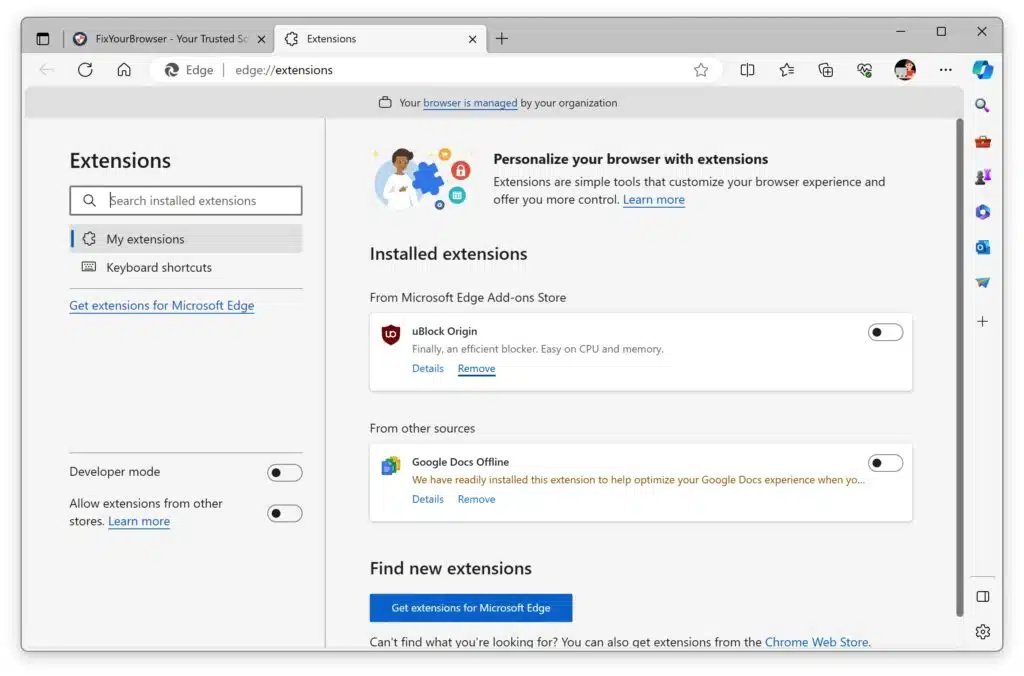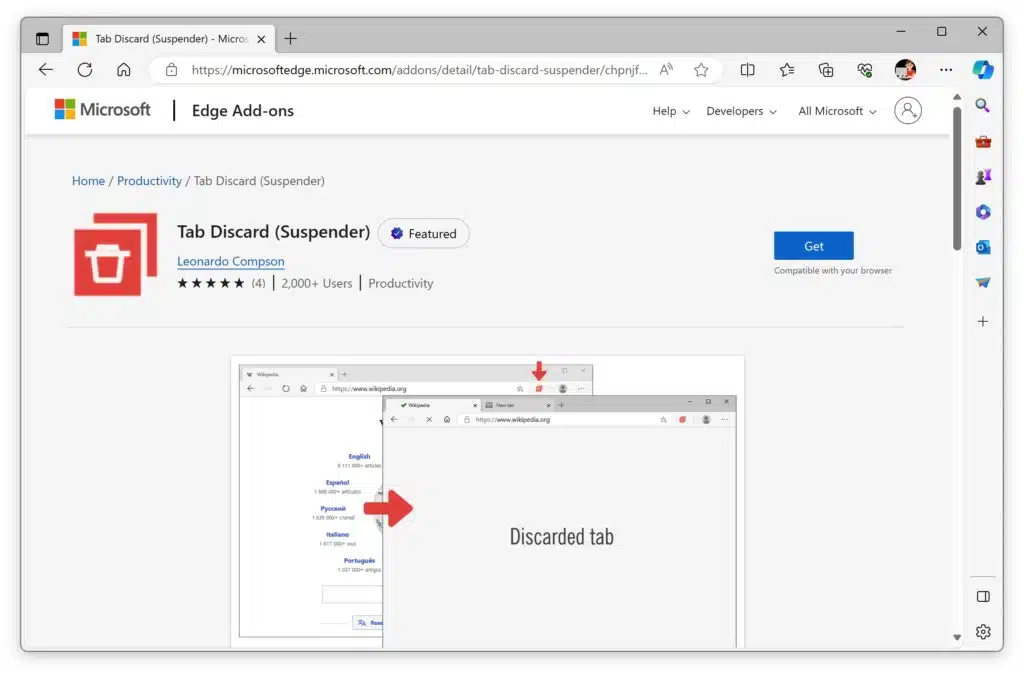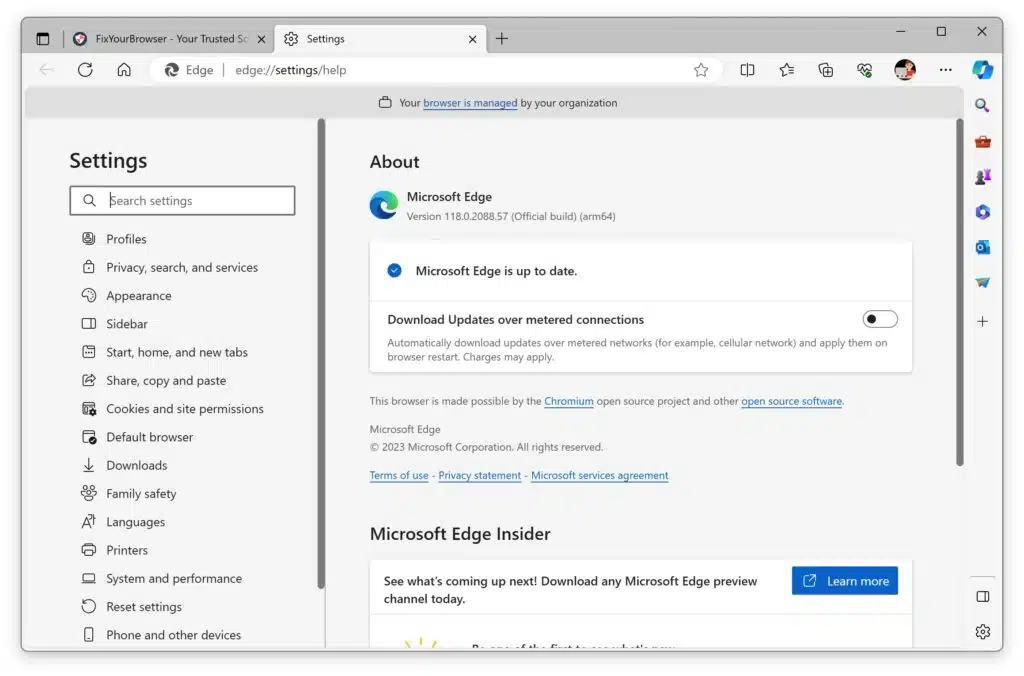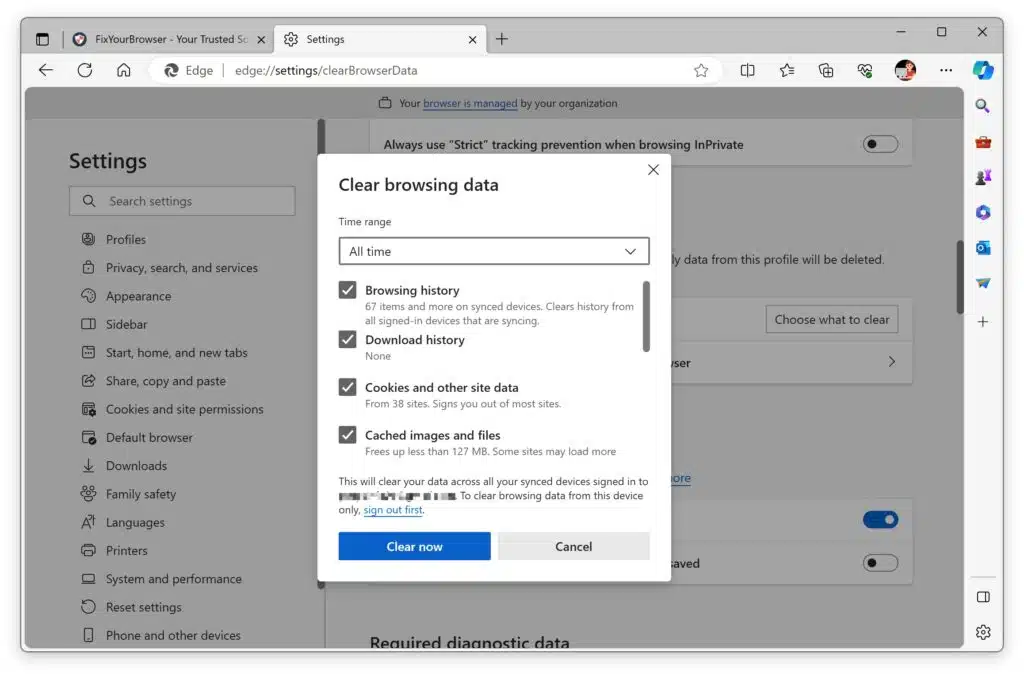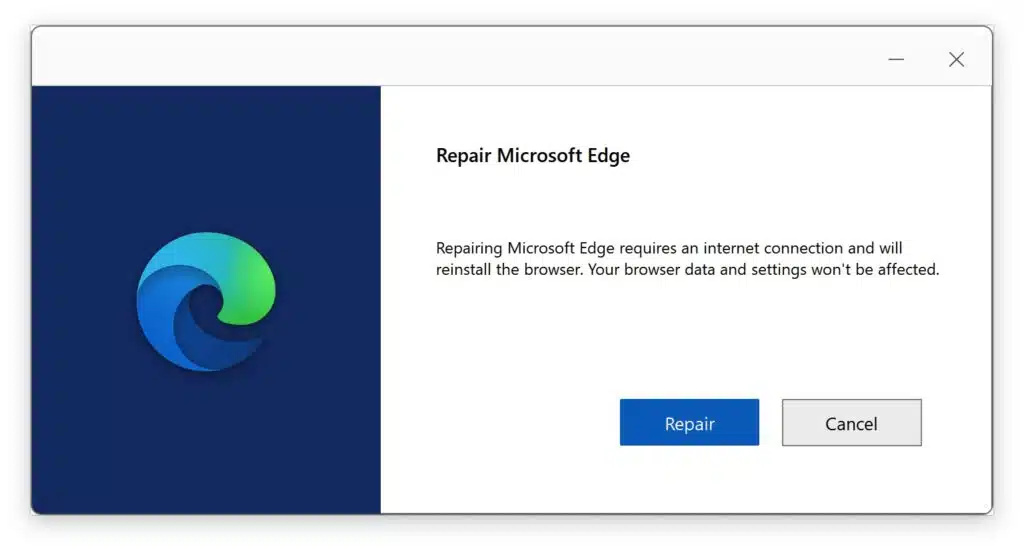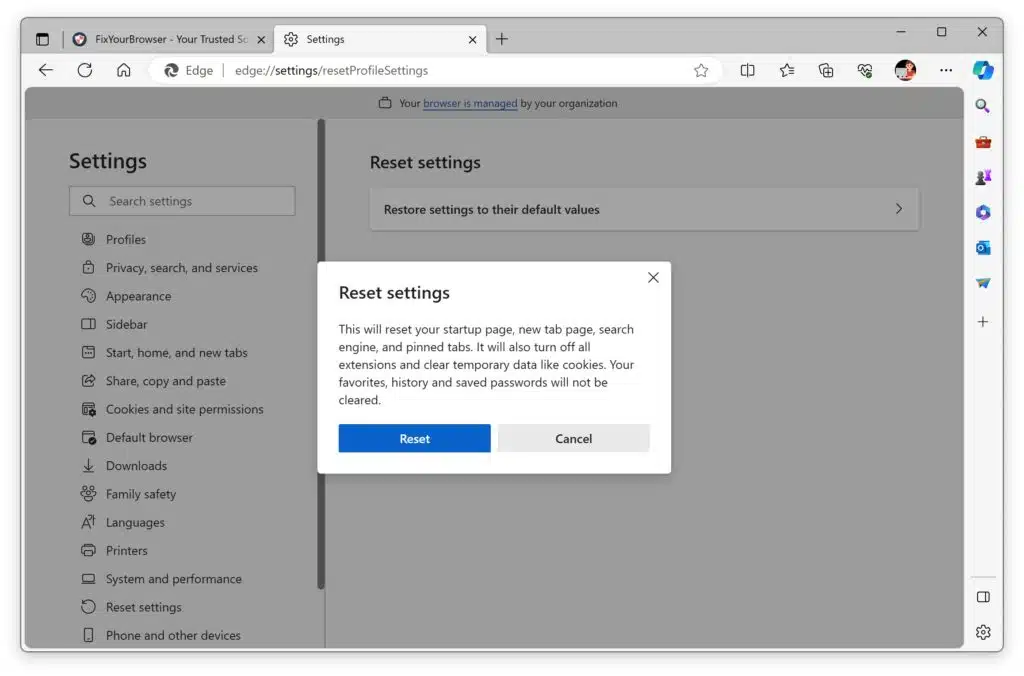Are you tired of encountering the frustrating “Error code out of memory” message in your Microsoft Edge or Chrome browser? No need to worry; I’ve got you covered! As someone who has encountered this error many times, I’ve done some research. I gathered helpful insights to assist you in resolving this bothersome issue.
This error typically occurs when your browser doesn’t have available memory for allocation. It can be triggered by factors such as having an excessive number of extensions and add-ons, having multiple tabs open simultaneously, or simply lacking sufficient memory on your computer. Outdated versions of browsers and interference from cookies and cache can also contribute to this problem.
You can take steps to fix this error and resume seamless browsing. You might consider trying out browsers, clearing cache and cookies, removing unnecessary extensions, and adding or reducing your browser’s memory usage. Repairing or resetting Microsoft Edge could also do the trick. Additionally, adjusting the page filing settings can help optimize virtual memory allocation.

Understanding the MS Edge Error Code Out of Memory
The “Error code out of memory” is a familiar issue users encounter when using Microsoft Edge and Chrome browsers. This error occurs when insufficient memory is available for allocation, leading to browser performance issues and potential crashes. This section will explore the possible causes of this error and discuss various troubleshooting steps to resolve it.
Causes of the Error
Several factors can contribute to the “Error code out of memory” in Microsoft Edge. Some of the common causes include:
- Too many Edge extensions and add-ons: An excessive number of extensions and add-ons can consume a significant amount of memory, resulting in errors.
- Multiple tabs open: Opening multiple tabs simultaneously can strain the browser’s memory resources, leading to the error.
- Insufficient memory on the computer: If your computer does not have enough available memory, it can cause an error.
- Outdated version of Edge: Using an outdated version of Microsoft Edge may result in compatibility issues and memory allocation problems, triggering the error.
- Interference from cookies and cache: Accumulated cookies and cache files can impact browser performance and contribute to memory-related errors.
Troubleshooting Steps
To fix the “Error code out of memory” in Microsoft Edge, you can try the following troubleshooting steps:
- Try alternative browsers: If the error persists, consider using alternative browsers like Mozilla Firefox or Safari to determine if the issue is specific to Microsoft Edge.
- Clear cache and cookies: Clearing the cache and cookies can help resolve website formatting and loading issues, improve browsing security, and potentially address the error.
- Remove extensions and add-ons: Remove excessive extensions and add-ons from Microsoft Edge to reduce memory usage and improve browser performance.
- Reduce memory usage: Use the Browser Task Manager to identify and end processes that consume a lot of memory. This can help free up memory resources and alleviate the error.
- Repair Microsoft Edge: Utilize the built-in repair option in Microsoft Edge to restore default settings, clear cookies and cache, and potentially fix any underlying issues causing the error.
- Reset the browser: Resetting Microsoft Edge using different methods, such as through the browser settings or command prompt, can also help resolve the error by restoring the browser to its default state.
- Change page filing settings: Adjusting the settings can optimize virtual memory allocation and potentially resolve the error. Consult online resources or seek professional assistance for guidance on adjusting these settings.
- Basic troubleshooting steps: Sometimes, a simple computer and browser restart can help resolve temporary memory issues and fix the error.
It is worth noting that the “Error code out of memory” can also occur in other browsers. Therefore, similar troubleshooting steps can be followed to address the issue. By implementing these solutions, you can improve the performance of your browser and alleviate memory-related errors.
You can refer to the source mentioned in this section for more information and additional troubleshooting steps.
How to Fix MS Edge Error Code Out of Memory?
Too Many Extensions and Add-ons
One of the leading causes of the “Error code out of memory” is having too many extensions and add-ons installed in the browser. While these extensions can enhance functionality and provide additional features, they consume system resources. Each extension runs in the background, utilizing memory and processing power. When too many extensions are active simultaneously, it can quickly deplete the available memory, resulting in an error. Reviewing and removing unnecessary or unused extensions to mitigate this issue is advisable.
Removing extensions and add-ons from Microsoft Edge is a straightforward process. Here are the steps to follow:
- Open Microsoft Edge and click on the three-dot menu icon in the top-right corner of the browser window.
- From the drop-down menu, select “Extensions” to open the Extensions page.
- On the Extensions page, you will see a list of all the installed extensions. Review the list and identify any extensions that you no longer need or use.
- To remove an extension, click the “Remove” button next to it.
- Confirm the removal by clicking “Remove” again when prompted.
- Repeat this process for any other extensions you wish to remove.
Removing unnecessary extensions and add-ons can declutter your browser and potentially eliminate the “Error code out of memory” issue.
Multiple Tabs Open
Another common factor contributing to the “Error code out of memory” is having many tabs open simultaneously. Each open tab consumes memory, and when numerous tabs are active, it can strain the system resources. This can lead to the browser running out of memory and triggering the error. To alleviate this issue, users can try closing unnecessary tabs or utilizing browser features like tab suspension or grouping to reduce memory usage.
Limited Computer Memory
Insufficient system memory is a significant cause of the “Error code out of memory.” If the computer has low RAM capacity, the browser may struggle to allocate enough memory for its operations, resulting in an error. In such cases, upgrading the computer’s memory or closing resource-intensive applications running in the background can help alleviate the problem.
- Open Task Manager:
- Windows: Press Ctrl + Shift + Esc or Ctrl + Alt + Del and select “Task Manager” from the menu.
- Mac: Open “Activity Monitor” from the Utilities folder in Applications.
- Sort by CPU Usage:
- Windows: In the “Processes” tab, click on the “CPU” column header. This will sort all processes based on their CPU usage. Processes consuming the most CPU will be at the top.
- Mac: In the “CPU” tab of Activity Monitor, processes are listed by default in descending order of CPU usage.
- Sort by Memory Usage:
- Windows: In the “Processes” tab, click on the “Memory” column header. This will sort all processes based on their memory usage. Processes consuming the most memory will be at the top.
- Mac: In the “Memory” tab of Activity Monitor, processes are listed by default in descending order of memory usage.
- Look for Unfamiliar Processes: If you see processes you don’t recognize or aren’t associated with any software you currently use, it might be worth investigating further. Some malware or unwanted software might consume a lot of resources.
- Check Disk and Network Usage (Windows):
- In the “Processes” tab of Task Manager, you can also sort by “Disk” or “Network” to see which processes are heavily using these resources.
- End Heavy Processes:
- Windows: Right-click on the process and select “End Task” to stop it. Be cautious when ending processes; some might be critical for system operation.
- Mac: Select the process and click the “X” button in the top-left corner of the Activity Monitor window. Again, be cautious when quitting processes.
Outdated Version of Edge
Using an outdated version of Microsoft Edge can also contribute to the “Error code out of memory.” Older browser versions may have memory management issues or lack optimizations that improve memory utilization. Updating the browser to the latest version can often resolve these issues and provide better memory management, reducing the occurrence of errors.
- Launch the Microsoft Edge browser on your computer.
- Click on the three horizontal dots (sometimes called ellipses) in the browser window’s top right corner to open the main menu.
- Hover over or click “Help and feedback” at the bottom of the dropdown menu.
- From the submenu, click on “About Microsoft Edge.”
- Edge automatically checks for updates when you access the “About Microsoft Edge” page. If an update is available, Edge will start downloading it automatically.
- Once the update is downloaded, you might be prompted to restart the browser to complete the installation. If so, save any work in open tabs and click the “Restart” button.
- After restarting, you can return to the “About Microsoft Edge” page to confirm that your browser is up to date. It should display a message like “Microsoft Edge is up to date.”
Cookies and Cache Interference
Interference from accumulated cookies and cache can also lead to the “Error code out of memory.” Over time, these temporary files can grow in size and affect browser performance. Clearing the cache and cookies regularly improves browsing speed and resolves website formatting and loading issues. This can help free up memory and mitigate the error.
To summarize, the “Error code out of memory” in Microsoft Edge can stem from various causes, such as excessive extensions and add-ons, multiple open tabs, limited computer memory, outdated browser versions, and interference from cookies and cache. By understanding these factors, users can take appropriate steps to resolve the error and enhance the performance of their browser.
Clearing the cache and cookies in Microsoft Edge is a straightforward process. Here’s a step-by-step guide to help you through it:
- Open Microsoft Edge on your computer.
- Click on the three-dot menu icon in the top-right corner of the browser window.
- From the drop-down menu, select “Settings.”
- In the Settings menu, scroll down and click on “Privacy, search, and services.”
- Under the “Clear browsing data” section, click “Choose what to clear.”
- Check the boxes next to “Cookies and other site data” and “Cached images and files.”
- Optionally, you can select other data you want to clear, such as browsing history or saved passwords.
- Click on the “Clear” button to remove the selected data.
- After the clearing process is complete, close and reopen Microsoft Edge.
By following these steps, you can effectively clear the cache and cookies in Microsoft Edge, resolving any potential memory-related issues that may be causing the “Error code out of memory” error.
Remember to save any important information or passwords before clearing the cache and cookies, as doing so will remove stored data from your browser.
Try Alternative Browsers
It might be worth considering alternative browsers if you constantly face the “Error code out of memory” in Microsoft Edge. Popular options like Google Chrome, Mozilla Firefox, or Opera could provide a more stable browsing experience. Give them a try and see if the error persists.
Repair Microsoft Edge
If the previous methods haven’t resolved the error, you can attempt to repair Microsoft Edge. This process will restore the browser to its default settings and clear any accumulated cookies and cache that may be causing the error. Refer to the browser’s settings or preferences for the repair option.
- Open the Start menu and click on Settings (the gear-shaped icon).
- Go to Apps.
- In the Apps & features section, find and click on Microsoft Edge.
- Click on the Advanced Options link.
- In the new window, you’ll see the Repair option. Click on the Repair button. This will attempt to fix any issues with Edge without affecting your data.
Reset the Browser
A complete reset of Microsoft Edge might be necessary in more severe cases. This process reinstalls the browser, eliminating any persistent issues. However, resetting the browser will delete your browsing history, saved passwords, and other personalized settings. Make sure to back up any critical data before proceeding with the reset.
To reset default settings in Microsoft Edge, follow these simple steps:
- Open Microsoft Edge and click the three-dot menu icon in the top-right corner.
- Select “Settings” from the drop-down menu.
- Scroll down and click on “Reset settings” under the “Reset and cleanup” section.
- In the confirmation prompt, click on the “Reset” button.
This will restore Microsoft Edge to its original state, clearing any customizations you have made and hopefully resolving the “Error code out of memory” issue.
Change Page Filing Settings
Adjusting the page filing settings can also help resolve the “Error code out of memory” in Microsoft Edge. Increasing the virtual memory allocation provides additional space for the browser to operate smoothly. Consult your computer’s settings or preferences to find the page filing settings and make the necessary adjustments.
Before diving into these advanced troubleshooting methods, starting with essential steps like restarting your PC and browser is always a good idea. Sometimes, a simple reboot can work wonders in resolving temporary glitches.
It’s important to note that these methods can also be applied to other browsers experiencing the “Error code out of memory.” So, even if you’re using a different browser, try these steps and see if they help. This is an advanced setting. Only modify it if you know what you are doing!
- Open the Control Panel on your computer. You can access it by searching “Control Panel” in the Windows Start menu.
- In the Control Panel, navigate to the “System and Security” section and click “System.”
- Next, click “Advanced system settings.”
- In the System Properties window, go to the “Advanced” tab and click on the “Settings” button under the “Performance” section.
- Another window will open. In this window, navigate to the “Advanced” tab and click on the “Change” button under the “Virtual Memory” in the “Advanced” section.
- Uncheck the box that says, “Automatically manage paging file size for all drives.”
- Select the drive where Microsoft Edge is installed (usually the C: drive) and choose the “Custom size” option.
- Enter the initial size and maximum size for the virtual memory allocation. It’s recommended to set both values to the same number, which should be larger than the currently allocated size.
- Click the “Set” button and “OK” to save the changes.
- Restart your computer to apply the new page filing settings.
Adjusting the virtual memory allocation gives Microsoft Edge more space to work with, potentially resolving the “Error code out of memory” issue.
Remember, it’s always a good idea to consult official documentation or seek professional assistance if you’re unsure about changing your computer’s settings.
I hope this helped. Thank you for reading!
